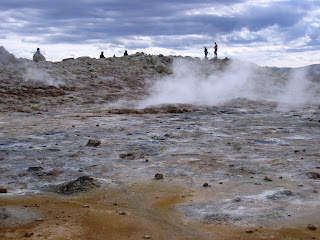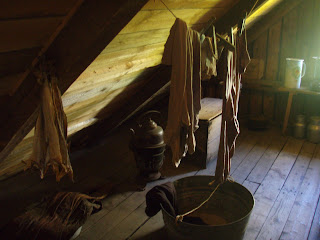Yes, part of my travels over the past two weeks did indeed include going to the Akureyri Hospital’s emergency room the day after hiking up a giant explosion crater, but the two weren’t actually related.
And I’m fine now, so no worries – but you’ll have to read on for the rest of the story.
My apologies, also, for what has turned out to be yet another long break between posts here. I had intended to write some sort of summing-up reflections about the shrimp survey, but the combination of Ada’s visit and a nasty sore throat provided hefty distractions and reflections what I’ve learned about fisheries management will have to wait (not that I have any answers). Despite my rather inconvenient sore throat, though, Ada and I managed to have some adventures and non-adventures in northern Iceland.
Our first intended destination was to cross Eyjafjörður at the Osholmar nature area just south of the Akureyri airport. I’d been there just before leaving for the shrimp survey, but wanted to go back, and it seemed like an ideal journey to explore in the Akureyri area. Unfortunately, the weather was pretty dreary – windy and rainy – and after it started raining on us and we took shelter at the town skating rink, where we glanced in on some kids practicing figure skating (having never made it around a rink without falling, I was impressed) and then huddled outside with our lunch before deciding to give up the initial attempt. Instead of getting more cold and wet, we headed back to the center of town and got some hot chocolate and played cards in a café and then stopped at the Akureyri swimming pool on the way back.
Now swimming might not seem like the kind of thing one does on a cold, rainy day, but swimming pools in Iceland are a little different from the kind of swimming pools one finds in the United States. Due to the readily-available hot water, maintaining a heated pool is relatively inexpensive, so pretty much every town in Iceland has a heated swimming pool, which means not just a normal pool for swimming laps but also multiple temperatures of hot tubs, water slides, steam baths, and saunas. You can read more about Iceland’s thermal swimming pools here. Since Akureyri is such a large town, at least by Iceland’s standards, the swimming pool is particularly fancy even for Iceland, and made a good place to stop and relax – our first in a sampling of a few of northern Iceland’s swimming pools.
The next day, though, we made a second attempt to cross the fjord and this time succeeded. It was still pretty cold, mostly because there was a strong wind blowing down the fjord towards us. We joked about measuring the wind on the Beaufort scale normally used for measuring wind forces at sea, since we actually had trouble walking into the wind – which, if you look it up, means “near gale” force winds. I didn’t take any pictures because I forgot to bring gloves and my hands were far happier safely tucked away than with my camera, but here’s one from the first time I crossed, looking toward the end of the fjord and the mountains to the south:

And another of a girl feeding the horses that are both kept and often ridden in the area (the girl wasn’t there when we went back, but there were still a lot of horses).

The initial plan for the rest of the week was: go to Lake Mývatn, one of the largest lakes in Iceland and a place pretty much Icelander had told me I should go while in the north, come back to Akureyri for day, take a ferry to the island of Grímsey, which lies on the Arctic Circle and is the most northerly inhabited place in Iceland, and stay for two days before coming back to Dalvik, a town half-way up the fjord and also where the Grímsey ferry sails from, for the Great Fish Day festival. This was, perhaps, a rather over-ambitious plan and, of course, things did not work out quite like that.
We postponed leaving for Lake Mývatn for a day because I woke up the morning we were planning to leave feeling pretty miserable, but after a rather unsuccessful day of trying to rest the cold away, we decided to go anyway. Despite feeling sick, I liked Lake Mývatn: we camped right next to the lake, where we got to watch people going out on row boats and the slow sunset over the water and were woken up in the morning by rather loud birds.
This was the view of the sunset (at about 10pm, of course) looking out from our tent: 
And this was the view in daylight (that’s our tent, with Ada and drying clothes outside): 
The area looks very unlike any lake I’ve seen before – it’s along the zone of Iceland’s most recent volcanic activity (the lava flows from Krafla, which erupted from 1975-1984, are visible just to the north), which means that the lake is situated on a base of basalt flows and is surrounded by volcanoes, craters, and odd basalt formations from old lava flows. We hiked a few kilometres south to Hverfell, a huge tephra (fancy geology word for stuff that exploded out of a volcano…I did spend the past four years studying geology, you know) explosion crater – 1000 meters in diameter and 140 meters deep. It’s hard to get a sense of scale from the picture, but we could tell it was pretty darn big from quite a ways away as we walked towards it:

And here’s Ada on the rim, looking down into the crater. Yup, it was pretty exciting to make it all the way up.

You can also see (if you click to see the larger version of the picture) that lots of visitors seem to have decided to leave their mark on the crater in a rather impressive display of rock graffiti on the part of the cone that collapsed in a landslide after the eruption – lots of country names, some names, and some words we couldn’t quite decipher all written out on the center of the crater. Amusing, although it does slightly mar the wonder of, “wow, this whole thing exploded!”
Walking around the rim also provided an impressive view of the surrounding area.
Looking out over Lake Mývatn, where you can actually see some of the smaller craters emerging from the lake as small islands: 
Looking to the south, the green area is an old lava lake called Dimmuborgir with strange formations with lava tubes and arches, and a variety of volcano types including the classic flat-topped volcano on the left, which formed by erupting underneath a glacier: 
And looking back north across the crater, you can see the smoke and the lava fields around Krafla:

We also got a chance to see some of Reykjahlíð, the small town we were staying in by the lake. Most people who visit Lake Mývatn go to the Mývatn Nature Baths, but we opted to go to the local swimming pool. Despite Reykjahlíð only having 300 inhabitants, it has a swimming pool with two hot tubs and a sauna (my first time in a sauna since I was in Finland nine years ago). The pool was mostly empty – it was a bank holiday and I suspect most people in town had gone elsewhere to celebrate – but we stayed for a while and watched an Icelandic baby and his father explore the pool together and played cards and listened to the Icelandic radio, which I continue to be amused by with its mixture of a whole range American music styles along with Icelandic songs.
After we got back to the tent from swimming, though, we decided that I needed to see a doctor when we returned to Akureyri the next day because my sore throat was getting increasingly icky (Ada looked in my throat using my headlamp as a light), mostly to see whether I had a recurrence of the strep throat I’d had at the beginning of the summer and if so, get a prescription for antibiotics. So the next morning, we packed up and went back to Akureyri and headed to the hospital.

I found going to the emergency room for a sore throat a particularly strange experience, not so much because I was going to a hospital in a foreign country as because, thanks to growing up with two doctors, I’ve never gone to the emergency room for basic medical needs. Wasn’t too difficult though – they even had a special form for non-Icelanders for me to fill out, the doctor was very helpful (even though the rapid strep test came back negative, he prescribed me erythromycin just in case and gave me directions to the pharmacy to pick it up the next morning), and even though I don’t get the incredibly low prices that Icelanders pay for health care (85% government funded) it was still only about $100 for the visit.
This did mean that rather than going to Grimsey the next morning, we spent the next few days in Akureyri. We had a good time, though – we took advantage of the time to relax and cook and play a lot of card games. Among the excitements of spending time in Akureyri were the discovery that cookie dough is a fabulous food that requires no oven if you have no intention of actually making cookies (we realized that the dough tasted better than the cookies), that the readily-available Mexican-style food in Iceland (tortilla chips, salsa, etc.) are produced – of all unlikely places – in the Netherlands, and that it is fairly easy to discover new card games by looking them up online. We played an incredible number of card games: in addition to games we already knew, including experimenting with variations on the rules of Casino, we also learned German Whist (which turns out to be British), Cuarenta (the national card game of Ecuador), and Bela/Clobyosh (apparently both a Yiddish and a Scottish card game…odd, but cool). A very international adventure in card playing, all from northern Iceland! I include the rules here as recommendation that you learn to play these games so you can play with me when I next see you, as it’s hard to keep up my card game skills on my own and these are an excellent set of games.
Anyway, that takes us to the end of last week and the end of the worst of my feeling sick, when we set off for Dalvik to join in the celebrations of the Great Fish Day, which will be coming soon in another post. All in all, though, being sick turned out to be not all that bad, despite the inconvenience and few days of feeling rather miserable. Hlynur told me I should learn the Icelandic phrase for “it’ll work out,” which of course I’ve now forgotten in Icelandic, but I think he was right.





















































